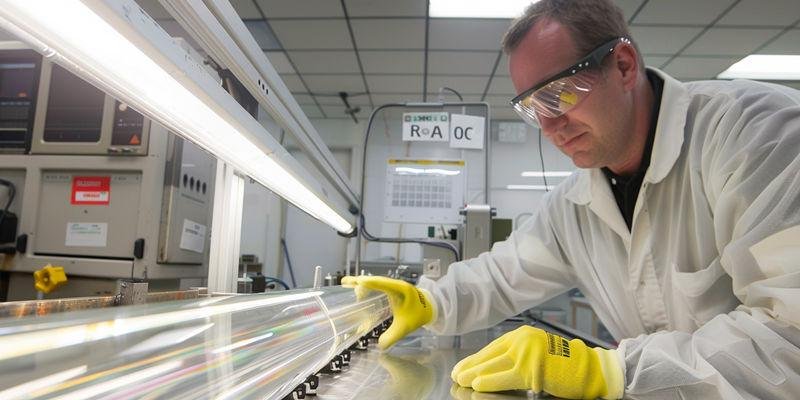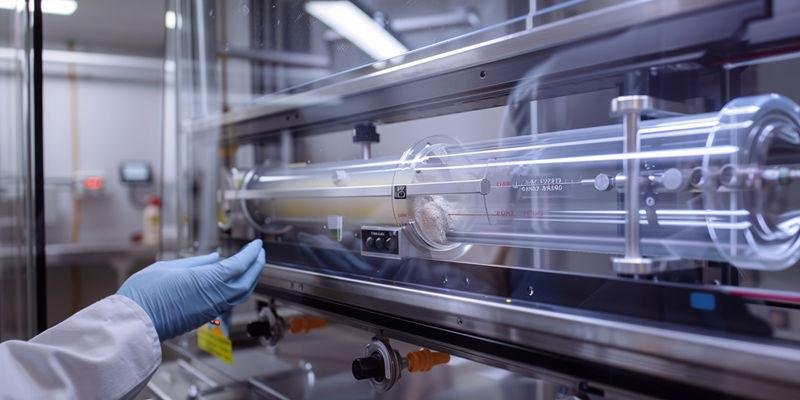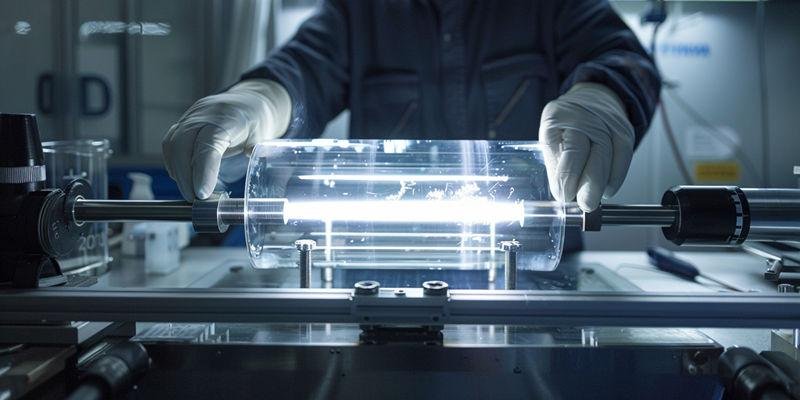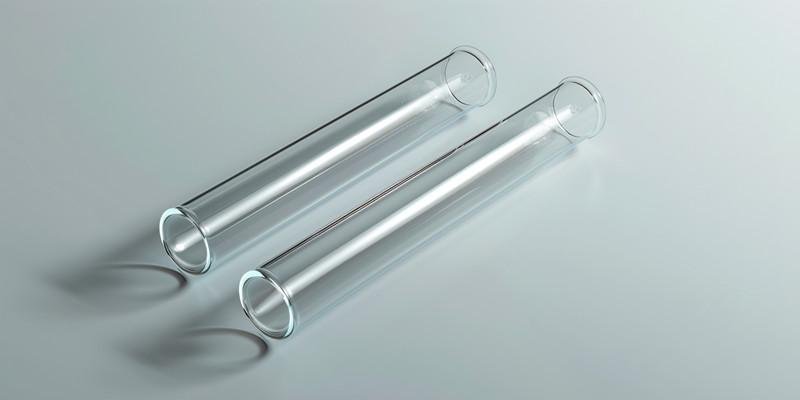
Quartz tube applications industrial uses span lamp manufacturing, semiconductor processing, photovoltaic production, chemical processing, and laboratory equipment. Each industrial application relies on the unique properties of clear fused quartz tube, such as high-purity silica composition, resistance to extreme temperature, and chemical durability. The following table highlights the key industrial uses and the reasons fused quartz tubing meets strict technical demands:
Application | Description |
|---|---|
Lamp Applications | Used in UV and halogen lamps for high temperature and UV resistance. |
Semiconductor | Critical for wafer processing and CVD in high-precision manufacturing. |
Photovoltaic | Utilized in solar cell production, especially for high-temperature steps. |
Others | Includes chemical processing and laboratory instruments needing high-purity materials. |
Quartz features thermal stability above 1,000°C, chemical inertness, mechanical strength, and thermal shock resistance, making it ideal for demanding applications across various temperature ranges.
Key Takeaways
Fused quartz tubes excel in high-temperature applications, withstanding temperatures up to 1200°C, making them ideal for semiconductor and ceramic processing.
High-purity silica in quartz tubes prevents contamination, ensuring reliability in sensitive processes like semiconductor manufacturing and pharmaceuticals.
Quartz tubes transmit over 90% of UV light, making them essential for effective sterilization and UV curing processes in various industries.
The low thermal expansion of quartz minimizes the risk of cracking during rapid temperature changes, enhancing durability in demanding environments.
Engineers should prioritize purity, thermal resistance, and supplier quality when selecting quartz tubes to ensure optimal performance in industrial applications.
How Do High-Temperature Furnace Applications Utilize Quartz Tubes?
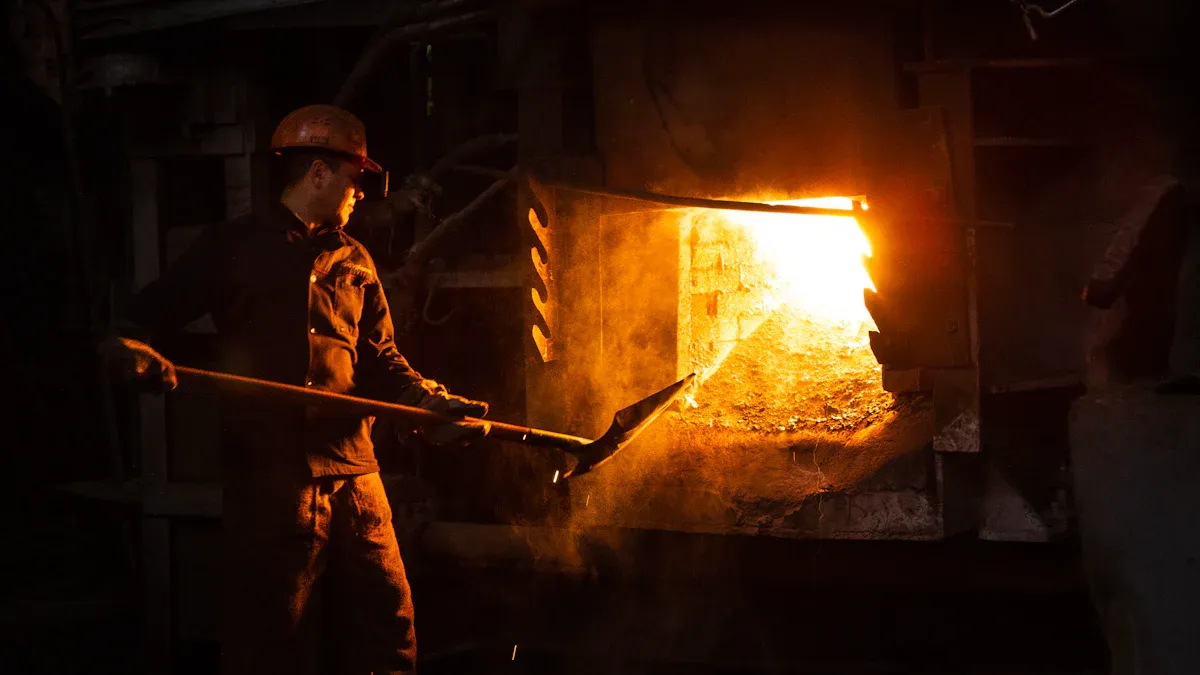
High-temperature furnace environments demand materials that can withstand extreme heat, rapid temperature changes, and exposure to reactive chemicals. Quartz tube applications industrial uses in these settings rely on the unique properties of clear fused quartz tube, such as high-purity silica composition and exceptional thermal shock resistance. The following sections explain how fused quartz tubing supports critical processes in semiconductor manufacturing, ceramic processing, and metal heat treatment.
CVD and Diffusion Process Requirements in Semiconductor Manufacturing
Semiconductor manufacturing depends on high-purity fused quartz tubes for chemical vapor deposition (CVD) and diffusion processes. These tubes prevent contamination of silicon wafers, ensuring device reliability. Their use supports the production of advanced integrated circuits.
High-purity silica in quartz tubes reduces the risk of defects, which improves yield and reliability. The semiconductor industry values thermal shock resistance and chemical stability, as these properties allow repeated rapid cycling and uniform thin-film deposition. Surface smoothness also helps maintain clean gas flow and wafer suspension.
Quartz tube applications industrial uses in CVD chambers and diffusion furnaces highlight the importance of purity and performance.
Key Points:
High purity prevents metal contamination.
Thermal shock resistance enables rapid cycling.
Chemical stability ensures process consistency.
Materials Sintering and Ceramic Processing Parameters
Ceramic processing and materials sintering require precise control of temperature and atmosphere. Fused quartz tubing can operate at temperatures up to 1,200°C in standard furnaces, with sintering often occurring between 1,200°C and 1,350°C. These conditions promote densification and uniformity in ceramic products.
Low thermal expansion in quartz minimizes stress and cracking during heating and cooling cycles. This property allows manufacturers to achieve high-quality results in demanding applications. Controlled environments, such as vacuum or inert gas, further enhance process outcomes.
Material | Volume Expansion (liters) |
|---|---|
Stainless Steel | 28 |
Borosilicate Glass | 5 |
Fused Quartz | <1 |
This table shows that fused quartz’s low expansion directly reduces the risk of thermal failure, making it ideal for ceramic processing.
Metal Heat Treatment Under Controlled Atmospheres
Metal heat treatment processes use quartz tubes to create stable, controlled environments for annealing and other thermal treatments. These tubes withstand temperatures from 1,100°C to 1,450°C, supporting a wide temperature range for different metals. In vacuum or inert atmospheres, quartz maintains its integrity and prevents unwanted reactions.
Manufacturers select quartz for its high melting point and resistance to rapid heating rates. The material’s durability ensures consistent results, even during repeated cycles. High purity fused quartz also prevents contamination during sensitive processes.
Summary:
Wide temperature range supports various metals.
High purity prevents contamination.
Durability ensures long service life.
What Optical and UV Applications Require Quartz Tube Transparency?

Quartz tube transparency plays a vital role in many optical and UV applications. Industries rely on the unique optical clarity and high-purity silica composition of fused quartz tubing to achieve precise results. These applications span sterilization, curing, photochemical reactions, and high-intensity lighting.
Germicidal UV Lamp Design for Sterilization Systems
Germicidal UV lamps use clear fused quartz tube envelopes to deliver effective sterilization. The high melting point and excellent UV transmissivity of quartz enable these lamps to emit germicidal wavelengths that inactivate bacteria and viruses. This property ensures reliable performance in medical, water, and air purification systems.
Quartz tube applications industrial uses in sterilization systems depend on the ability to transmit UVC light efficiently. Other glass materials cannot match the UV transmittance and long-term clarity of fused quartz, making it indispensable for environments where consistent sterilization is critical. Typical lamp designs use tubes with diameters around 22 x 25 mm and wall thicknesses of 1.5 mm to optimize both strength and light output.
Key Points:
High UV transmission ensures germicidal effectiveness.
Thermal stability supports continuous operation.
Long-term clarity maintains lamp performance.
UV Curing Process Optimization in Industrial Applications
UV curing processes in manufacturing require high-purity quartz tubes to maximize efficiency. These tubes transmit over 90% of ultraviolet light, which accelerates the curing of inks, coatings, and adhesives. Their chemical inertness prevents contamination, while high-temperature stability reduces maintenance and downtime.
Fused quartz tubing filters out unwanted infrared radiation, protecting substrates and system components from overheating. This controlled temperature environment is essential for applications that demand precise thermal conditions. The optical clarity of quartz supports rapid, uniform curing, improving throughput and product quality.
Manufacturers select quartz for UV curing because it combines chemical resistance, optical performance, and durability.
Key Points:
Over 90% UV transmission speeds up curing.
Chemical inertness prevents process contamination.
Temperature control protects sensitive materials.
Photochemical Reactor Configuration and Light Distribution
Photochemical reactors depend on the optical properties of fused quartz tubes to drive chemical reactions. These tubes provide excellent light transmission across the UV to IR spectrum, which enhances reaction efficiency. High resistance to thermal shock and chemical attack ensures durability and sample purity.
Consistent light access to reactive substances is crucial for effective photochemical processes. Fused quartz maintains this access even during prolonged operation, supporting uniform light distribution throughout the reactor. The ability to withstand continuous use at high temperatures, up to 1100°C, further increases reactor reliability.
Property | Description |
|---|---|
Light Transmission | >93% visible, >80% UV; boosts reaction efficiency |
Thermal Stability | Continuous use up to 1100°C; supports reactor operation |
Chemical Resistance | Maintains sample purity; resists aggressive chemicals |
High-Intensity Lighting Envelope Requirements
High-intensity lighting systems, such as those used in stadiums and automotive headlights, require quartz tubes for their optical clarity and thermal stability. Fused quartz, with over 99% SiO2 content, endures temperatures up to 1400°C while maintaining structural integrity. The low coefficient of thermal expansion allows these tubes to resist temperature fluctuations and thermal shock.
Lighting applications benefit from the excellent transparency of quartz, which ensures efficient light transmission and consistent illumination. The durability of quartz extends the lifespan of lighting systems, reducing replacement frequency and maintenance costs. These properties make quartz the preferred material for demanding lighting environments.
Property | Value/Benefit |
|---|---|
Thermal Expansion Coefficient | 5.5 × 10⁻⁷ /°C; resists thermal stress |
Service Temperature | ≤ 1000°C continuous, up to 1200°C short-term |
Optical Clarity | Ensures efficient light output and system longevity |
How Are Quartz Tubes Used in Chemical Processing and Corrosive Environments?
Quartz tube applications industrial uses extend into chemical processing and corrosive environments where durability and purity are essential. Engineers select clear fused quartz tube for its ability to withstand aggressive chemicals and maintain structural integrity at high temperature. These applications rely on the unique properties of fused quartz tubing to ensure safety, reliability, and compliance with strict industry standards.
Sight Glass and Level Gauge Applications in Aggressive Media
Sight glass and level gauge systems often operate in harsh chemical environments. Engineers must design these components to handle pressures higher than normal operation and account for potential overpressure events. They also follow safety standards such as API Standard 521 to prevent failures.
Designers consider several factors when specifying quartz for these applications. They assess the risk of impact damage, the corrosive nature of the process fluid, and the maximum temperature during process upsets. Proper engineering ensures the glass does not act as a pressure relief device and maintains safety even in extreme conditions.
Quartz provides a reliable solution for aggressive media due to its chemical resistance and mechanical strength.
Factor | Description |
|---|---|
Pressure | Must exceed normal and upset conditions to prevent burst failure |
Impact damage risk | Requires evaluation of both impact and corrosion from strengthening methods |
Process fluid | Corrosive fluids demand careful material selection to avoid galvanic corrosion |
Maximum process upset temp | Higher temperatures increase chemical activity and risk |
Normal service temperature | Use maximum upset temperature for specification if it persists |
Pharmaceutical Process Equipment Purity Requirements
Pharmaceutical manufacturing demands high-purity materials to prevent contamination. Fused quartz tubing meets these requirements by offering low contaminant and alkali levels, supporting the production of safe medicines. The high-purity silica structure ensures compliance with strict industry standards.
Quartz exhibits excellent thermal and optical properties, low thermal expansion, and high resistance to thermal shock. These features make it ideal for high-temperature pharmaceutical processes that require both durability and purity. Manufacturers trust quartz to maintain product quality and meet regulatory expectations.
High-purity fused quartz helps pharmaceutical companies achieve consistent results and protect patient safety.
Key Points:
Low contaminant levels support regulatory compliance.
Thermal shock resistance ensures durability in demanding processes.
High-purity silica maintains product integrity.
Long-Term Chemical Resistance Performance Data
Fused quartz demonstrates outstanding chemical resistance in industrial settings. It remains inert and stable when exposed to most acids, bases, and solvents, making it suitable for corrosive environments. Only hydrofluoric acid causes measurable reaction with quartz.
UV quartz tubes show virtually no reactivity to acids, even under high-temperature conditions. This stability ensures long service life and reduces maintenance needs in chemical processing plants. Operators rely on quartz for consistent performance over many years.
Quartz’s chemical resistance makes it a preferred choice for long-term use in harsh environments.
Property | Result |
|---|---|
Chemical resistance | Inert to most acids, bases, and solvents |
Reactivity | No measurable reaction except with hydrofluoric acid |
Service life | Long-term stability even at elevated temperatures |
Which Quality Standards Validate Quartz Tube Performance Across Applications?
Quality standards play a crucial role in ensuring that quartz tube applications industrial uses meet strict industry requirements. Engineers rely on these standards to verify that clear fused quartz tube products deliver consistent performance in demanding environments. The following sections explain how purity, dimensional accuracy, and thermal and optical properties are validated for critical applications.
Purity Analysis Methods and Acceptance Criteria
Manufacturers use advanced techniques to analyze the purity of fused quartz tubing. Inductively Coupled Plasma Optical Emission Spectroscopy (ICP-OES) measures trace elements, confirming high-purity silica content. This method ensures that only minimal impurities remain in the final product.
High-purity standards require at least 99.9% SiO₂, which reduces contamination risks in sensitive processes. Certificates of analysis document these results, providing confidence for engineers and procurement teams. Reliable purity analysis supports safe and effective use in manufacturing.
A summary table highlights the main purity validation methods and acceptance criteria:
Test | Method/Standard | Typical Criterion | Units |
|---|---|---|---|
Purity | ICP-OES / certificate | ≥99.9 SiO₂ | % |
Dimensional Tolerance Standards for Critical Applications
Dimensional tolerances ensure that quartz tubes fit precisely in their intended systems. Engineers specify outer diameter, wall thickness, and roundness to match application needs. Tight tolerances prevent leaks and mechanical failures during operation.
Critical applications often require tolerances as tight as 0.1 mm for outer diameter and wall thickness. Manufacturers use coordinate measuring machines and gauges to verify these dimensions. Consistent sizing supports reliable performance in high-stress environments.
The following table summarizes typical dimensional tolerance ranges:
Tolerance Type | Tolerance Range |
|---|---|
OD tolerance | 0.1 to 3 mm |
Wall thickness | 0.1 to 1 mm |
Ellipticity (max) | 0.1 to 3 mm |
Thermal and Optical Property Qualification Protocols
Thermal and optical property tests confirm that fused quartz tubing meets application demands. Dilatometry measures the coefficient of thermal expansion, ensuring the tube can withstand rapid temperature changes. Spectrophotometry checks optical clarity, which is vital for UV and visible light transmission.
Engineers require a coefficient of thermal expansion near 0.55×10⁻⁶ 1/K and mid-infrared emissivity above 0.90. These values guarantee that the tube maintains integrity and performance under extreme conditions. Reliable testing protocols support safe and efficient use in high-temperature and optical applications.
In summary, quality standards for quartz tube applications industrial uses provide assurance of safety, reliability, and performance.
High-purity silica ensures minimal contamination.
Precise dimensions support mechanical integrity.
Thermal and optical tests validate suitability for demanding environments.
How Should Engineers Select Quartz Tubes for Specific Process Conditions?
Engineers must evaluate several technical factors when choosing the right quartz tubes for their process needs. Each application places unique demands on material properties, dimensions, and quality standards. Careful selection ensures reliable performance and long service life in industrial environments.
Creating Technical Specifications for Procurement
Engineers start by defining the operating temperature, chemical exposure, and purity requirements for their process. They specify the internal and external diameters, length, and wall thickness to match the needs of their instruments. These details help prevent leaks and ensure compatibility with existing systems.
Procurement teams use these specifications to compare different types of fused quartz tubing. They check for high-purity grades when contamination control is critical, such as in semiconductor or pharmaceutical applications. Teams also consider the thermal resistance and low coefficient of thermal expansion to ensure the tubes withstand rapid heating or cooling cycles.
A clear technical specification reduces the risk of process failure and supports efficient procurement.
When engineers document all requirements, suppliers can deliver quartz tubes that meet strict industry standards.
Key Selection Factors for Quartz Tubes
Factor | Description |
|---|---|
Thermal Resistance | Maintains structure under fluctuating temperature. |
Low Coefficient of Thermal Expansion | Ensures stability during rapid heating or cooling. |
Optical Properties | Supports UV, visible, and infrared applications. |
Purity | Prevents contamination in sensitive processes. |
Dimensions | Matches instruments and process needs. |
Types of Quartz Tubes | Varies by application and performance requirements. |
Supplier Qualification and Quality System Assessment
Engineers must verify that suppliers can consistently deliver high-quality quartz products. They review supplier certifications, such as ISO 9001, and request batch-specific test reports for purity and dimensional accuracy. This process ensures that each shipment meets the technical requirements for the intended applications.
Teams assess the supplier’s quality control systems and track record for on-time delivery and product reliability. They may conduct audits or request samples to confirm that the quartz meets all performance criteria. Reliable suppliers help reduce downtime and prevent costly process interruptions.
A thorough supplier assessment builds confidence in the procurement process.
By selecting qualified partners, engineers ensure that fused quartz tubing will perform as expected in demanding environments.
Key Points:
Supplier certification confirms quality standards.
Test reports verify purity and dimensions.
Consistent quality supports reliable applications.
Quartz tubes support a wide range of industrial applications, from high-temperature furnaces to chemical processing and UV systems. Engineers must match tube properties, such as purity and thermal resistance, to each process and temperature range. Technical standards and quality validation help ensure reliable performance and long service life.
FAQ
What is the maximum temperature fused quartz tubes can handle?
Fused quartz tubes maintain strength at continuous temperatures up to 1200°C. Short-term exposure can reach 1450°C. These tubes outperform borosilicate glass in high-heat environments.
Quartz tubes provide reliable performance for industrial furnaces and reactors.
Why do UV sterilization systems use quartz tubes instead of regular glass?
Quartz tubes transmit over 90% of UVC light at 254 nm. Regular glass blocks most UVC, reducing sterilization effectiveness. Hospitals and water plants choose quartz for superior germicidal results.
Material | UVC Transmission (254 nm) |
|---|---|
Quartz Tube | >90% |
Regular Glass | <5% |
How does quartz tube purity affect semiconductor manufacturing?
Semiconductor-grade quartz contains at least 99.98% SiO₂ and less than 20 ppm metallic impurities. High purity prevents wafer contamination, which improves device reliability and yield.
Manufacturers rely on quartz tubes to maintain clean processing environments.
Can quartz tubes resist rapid temperature changes without breaking?
Quartz tubes have a low thermal expansion coefficient of 0.5 × 10⁻⁶ K⁻¹. They survive temperature changes over 1000°C per ASTM C1525 testing. This property allows safe, fast heating and cooling cycles.
Key Points:
Low expansion prevents cracking.
Thermal shock resistance supports rapid cycling.
Durability ensures long service life.
What certifications should buyers check when sourcing quartz tubes?
Buyers should verify ISO 12123 for purity, ASTM E438 for dimensions, and ISO 9050 for optical transmission. Certificates confirm that quartz tubes meet strict industrial standards.
Certification | Purpose |
|---|---|
ISO 12123 | Purity verification |
ASTM E438 | Dimensional accuracy |
ISO 9050 | Optical transmission |



